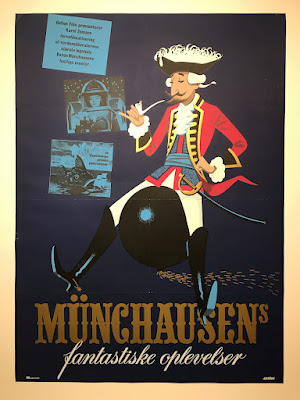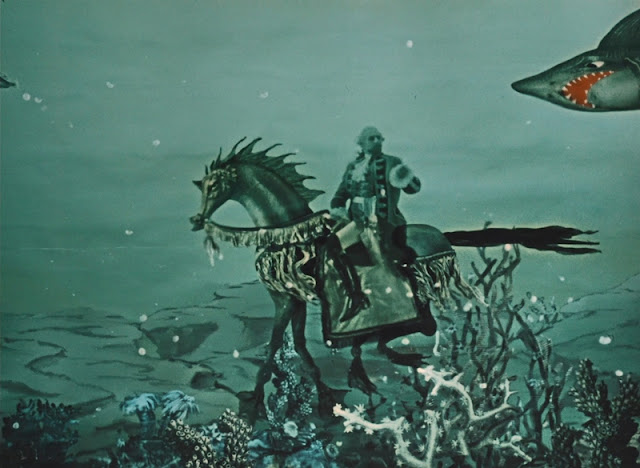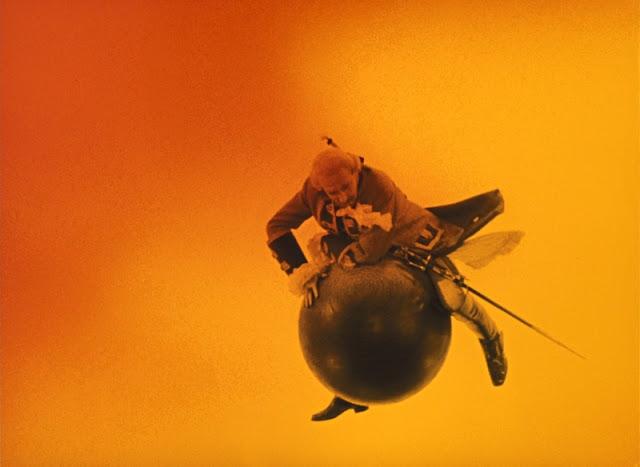(1962) Directed by Karel Zeman; Written by: Karel Zeman, Jirí Brdecka and Josef Kainar; Adapted from works by Gottfried August Bürger, Rudolph Erich Raspe and Gustave Doré; Starring: Milos Kopecký, Rudolf Jelínek, Jana Brejchová, Karel Höger, Rudolf Hrusínský, Jan Werich, Eduard Kohout and Bohus Záhorský; Available on Blu-ray and DVD
Rating: ****
“My one wish was to get the right idiom for my plan: to
capture the surreal world of Baron Munchausen. I wanted this romantic fantasy
to be unleashed from mundane reality, so I used imagery resembling prints from
the period. At the same time, I decided to treat color like a painter on a
canvas. I put it only where it was necessary.” – Karel Zeman (from Blu-ray
featurette, “Why Zeman Made the Film”)
A hearty thanks to Rebecca from Taking Up Room and Gill from Realweegiemidget Reviews for hosting the It’s in the Name of the Title Blogathon, spotlighting movie titles that feature their respective characters’ names. I’m proud to discuss, for your consideration, Karel Zeman’s aptly named The Fabulous Baron Munchausen (1962).
Since Rudolf Erich Raspe anonymously published his fictionalized account of Baron Munchausen’s* adventures in 1785, the exploits of the famous spinner of tall tales have enchanted and captivated readers. Raspe’s original work spawned a number of spinoff books, plays, radio shows, and of course, motion pictures. Munchausen became the subject of several silent-era films (including Georges Méliès 1911 short, “The Hallucinations of Baron Munchausen”). Sadly, many of the early short films are presumed lost, but arguably the most noteworthy cinematic examples are three feature-length films, released in 1943, 1962, and 1989, respectively. The infamous 1943 German version, The Adventures of Baron Munchausen, was made under the watchful eye of Hitler’s propaganda minister Joseph Goebbels (intended as a morale booster). While not overtly pushing a Nazi agenda, for many (including this reviewer) it’s impossible to separate the movie from its notorious origins and the monstrous regime that launched it. Terry Gilliam’s lavish, big-budget 1989 version, also titled The Adventures of Baron Munchausen gained its reputation as a troubled production, riddled with cost-overruns. Bookended between these versions was Czech filmmaker Karel Zeman’s The Fabulous Baron Munchausen, his third feature (after 1955’s Journey to the Beginning of Time and 1958’s The Fabulous World of Jules Verne (aka: Invention for Destruction). As with his previous movies, Baron Munchausen employed his knack for combining live action with animation.
* Fun Fact #1: Yes, Baron Munchausen was a real person. Munchausen,
the character, was based on the real-life Hieronymus Karl Friedrich von
Münchhausen, a retired German military officer, who was known for regaling
anyone who’d listen with wild stories of his exaggerated and imaginary exploits.
The opening scene finds the eponymous Baron (Milos Kopecký) traveling to the moon, where he encounters characters from Jules Verne’s From the Earth to the Moon, as well as (for some reason) Cyrano de Bergerac. He meets an astronaut named Tonik (Rudolf Jelínek), and believing him to be a resident of the Moon, decides to take him on a tour of Earth. Their first stop is Turkey, where they meet the despotic Sultan (Rudolf Hrusínský). Much to the Sultan’s chagrin, Munchausen and Tonik are smitten by Princess Bianca (Jana Brejchová),* who’s being held against her will. Thus begins a nominal love triangle, but it’s clear that Bianca only has eyes for Tonik. Although initially peeved at the princess’ preference for Tonik, the Baron’s jealousy doesn’t last long – after all, he only has one true love, himself. They hastily make their escape, with the Sultan’s army nipping at their heels. They’re rescued by a Dutch trading ship, but after they face the wrath of the vengeful Sultan’s navy, they’re cast adrift in the open ocean, where they’re subsequently swallowed by a giant fish. Their quixotic journey continues across the globe guided by the Baron’s indomitable wit and boundless imagination.
* Fun Fact #2: According to film writer Michael Brooke, at the time the film was released, Brejchová was more popular in her native Czech Republic than her husband, renowned director Milos Forman.
As a self-taught animator,*/** Karel Zeman honed his techniques with each project, working through the myriad challenges of his films like mathematical equations. Using Gustave Doré’s artwork as a template, his paper cutout animation resembles book illustrations that leapt off the pages. His signature blending of live action and animation creates a fairy tale look. Particularly impressive is a tracking shot through the Sultan’s palace, arranging multiple cardboard planes to create a three-dimensional space. He also frequently used split-screen techniques, combining live actors with paper cutouts in the background or foreground. The effects are delightfully old-fashioned, giving Zeman’s film a charm that can’t be compared to modern efforts. It's not about seamless integration of the imagery, but indicative of a different filmmaking tradition that favors creating fanciful visuals over hyper-realism. While I’m not going to initiate a debate about which approach is “better,” the analog, mostly in-camera effects never fail to entrance. Created by a small team of dedicated craftspeople, The Fabulous Baron Munchausen possesses a handmade quality that can’t be duplicated by a bunch of people clicking away on computers.
* Fun Fact #3: Zeman learned about the mechanics of animation by studying a “Felix the Cat” cartoon frame by frame.
** Fun Fact #4: Despite his early artistic predilections, Zeman’s
father forced him to attend business school.
Amidst the high fantasy, Karel Zeman reveals a sense of
humor worthy of a Warner Brothers cartoon. In one terrific gag, the Baron and
Tonik attempt in vain to break down some double doors in the Sultan’s palace,
only to watch Princess Bianca effortlessly open them. When Tonik innocently
steps on a rug in the Sultan’s throne room, he unwittingly triggers a swarm of
spears. And on the Dutch trading ship even the ship’s figurehead enjoys taking
a brief smoke break. Along with these playful flourishes, the film presents a satire
on the human condition. While in the presence of the mercurial Sultan, Baron
Munchausen speaks the “language of high diplomacy” (consisting of musical
harmonica sounds) as a means of communication.
In The Fabulous Baron Munchausen, Karel Zeman takes you to imaginary places that never existed, but you somehow wish they did. His approach to visuals is distinctly different compared to his contemporary Ray Harryhausen, but the end results are just as mesmerizing. Zeman’s version of Baron Munchausen argues that imagination and fantasy are more powerful than knowledge – and in the context of the distinctly engaging visuals, who could disagree? While Zeman left an indelible impression with his film, there’s something about Munchausen that transcends generations and bears repeating. Who knows when or where the next iteration of the indomitable Baron will take us, but one thing’s for certain: you can’t keep a good fibber down.
Sources for this article: “Why Zeman Made the Film” Blu-ray
featurette; “Baron Munchausen; Facts and Fibs,” by Michael Brooke; Film
Adventurer Karel Zeman (2015 documentary)








I adore these pictures and your post has got me really curious too
ReplyDeleteThanks for adding this to the blogathon and looking forward to our 2nd of a double bill later this year.
Thanks, Gill! It was tough capturing the flavor of this movie with just a handful of stills, but I'm glad to hear that it piqued your interest. It's such a joyous film. Thanks for co-hosting another terrific blogathon! I look forward to our 2nd collaboration. :)
DeleteWhat a beautifully written and illustrated encapsulation of the screen treatments of this classic story. All look visually stunning, though it looks like the Georges Méliès is the most impressionistic...want to see all these and read the source material again!
ReplyDelete-Chris
Thank you, kind sir! I had a blast reviewing this movie. It's easy to see why it's capivated so many people for generations.
DeleteI saw this film, along with Quatermass and the Pit, at a comic convention back in the early '70s, and was completely blown away. Zeman's style, inventiveness and sense of humor is truly one of kind, unforgettable. This film was unavailable for decades, so I was ecstatic when Criterion came out with their Fantastic Journeys of Karel Zeman collection.
ReplyDeleteIt's such an enchanting film. And I'm envious that you got to experience this with Quatermass and the Pit (my all-time favorite Hammer title). I recently purchased this film on an import Blu-ray, but judging from the pristine picture quality, it must have been from the same master as the Criterion version. What a visual treat.
ReplyDeleteThis is a fabulously beautiful film, like many of Zeman's movies - The Deadly Invention aka The Fabulous World Of Jules Verne is, if anything, even more amazing to look at, although in black and white, and The Stolen Airship has some of the humour and visual style of this film.
ReplyDeleteAll Zeman's films, incidentally, are available on order from the Karel Zeman Museum in Prague, about half on Blu Ray - I got my Blu Rays of his movies from there, before Criterion released them - then got the Criterion ones as well, anyway, because that's how much I love these films!
This is a beautiful film, indeed. I've only seen Zeman's first three feature films, but I fell in love with them instantly. So much innovation and humor on display.
DeleteThanks for the tip regarding Zeman's other films. I need to check them out next!
Na Komete (On the Comet, or Off on a comet) is also fun, but a bit more bonkers, and some of the effects are 'overly ambitious'. But they are all amazingly watchable - when people say they don't make them like they used to, these are the sorts of movies they mean
DeleteIndeed. Karel Zeman was one of a kind.
DeleteThis looks like a wild ride! I'm really intrigued by his use of colour and sets, so I'll keep an eye out for this one.
ReplyDeleteIt's truly a delight. Zeman's animated effects never fail to make me smile. Thanks for dropping by! :)
DeleteGreat review, Barry! I'm only familiar with the 1989 version of Baron Munchausen and it really didn't do much for me.
ReplyDeleteThe version you reviewed sounds like it has an abundance of imagination and charm, but maybe I should actually read The source material sometime.
Thanks, John. The effects in this movie made me smile. I hope you get a chance to see it.
Delete... And I still need to read the source material as well! ;)
Adventure films? Yes, please! I need to find and watch it-great post! xox
ReplyDeleteThank you! :) This movie is pure fun.
DeleteI really enjoyed this superb post, Barry. When I started reading, I had no idea that, by the end, I'd seriously be wanting to see this movie. Loved your take on it, and the fun facts were like icing on the cake. Great stuff.
ReplyDelete-- Karen
Thank you very much! It's such a wondrous, visually inventive film. Zeman conveys the joy of filmmaking like few other directors can.
DeleteAh, this is cool. I just saw the Terry Jones "Munchausen," but this one looks way better. Thanks again for joining the blogathon, Barry--this was great. :-)
ReplyDeleteIt's so playful and visually inventive. Great fun! Thanks again for co-hosting!
Delete